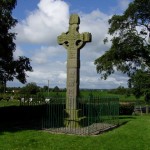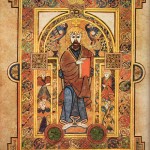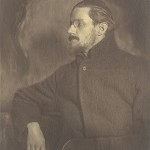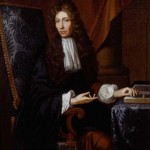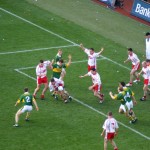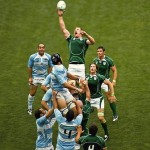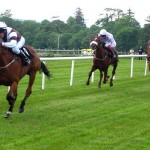This article is part of a series made available under the Creative Commons Attribution-ShareAlike License by Wikipedia.com
Culture of Ireland – Irish Arts, Literature & Theatre
Science and Technology – Sport in Ireland
Culture of Ireland
Ireland’s culture comprises elements of the culture of ancient immigration and influences (such as Gaelic culture) and more recent Anglicisation and Americanisation as well participation in a broader European culture. In broad terms, Ireland is regarded as one of the Celtic nations of Europe, which also includes Scotland, Wales and Brittany. The unique combination of Ireland’s cultural influences is visible most readily in the intricate designs termed Irish interlace or Celtic knotwork. These can be seen in the ornamentation of medieval religious and secular works. The style is still is popular today in jewelry and graphic art, as is the distinctive style of traditional Irish music and dance, and has become indicative of modern “Celtic” culture in general.
Religion has played a significant role in the cultural life of the island since ancient times. Since the 17th century plantations, religion been the focus of identity and divisions on the island also. Ireland’s pre-Christian heritage fused with the Celtic Church following the missions of Saint Patrick in the 5th century. The Hiberno-Scottish missions, begun by the Irish monk Saint Columba, spread the Irish concept of Christianity to pagan England and the Frankish Empire. These missions brought written language to an illiterate population of Europe during the Dark Ages that followed the fall of Rome earning Ireland the sobriquet, “the island of saints and scholars”.In more recent years, the Irish pubs, famous for the conviviality, have become outposts of Irish culture worldwide.
Back to Top
There are a number of languages used in Ireland. Irish is the main language to have originated from within the island. Since the later nineteenth century, English has become the predominant first language having been a spoken language in Ireland since the Middle Ages.Illustrated page from Book of Kells. A large minority claim some ability to use Irish today, although it is the first language only of a small percentage of the population. Under the constitution of the Republic of Ireland, both languages have official status with Irish being the national and first official language. In Northern Ireland, English is the dominant state language while Irish and Ulster Scots are recognised minority languages.
For an island with a relatively small population, Ireland has made a large contribution to world literature in all its branches, mainly in English. Poetry in Irish represents the oldest vernacular poetry in Europe, with the earliest examples dating from the 6th century. Jonathan Swift, still often called the foremost satirist in the English language, was wildly popular in his day for works such as Gulliver’s Travels and A Modest Proposal. Oscar Wilde is known for most for his often quoted witticisms.
In the 20th century, Ireland has produced four winners of the Nobel Prize for Literature: George Bernard Shaw, William Butler Yeats, Samuel Beckett and Seamus Heaney. Although not a Nobel Prize winner, James Joyce is widely considered one of the most significant writers of the 20th century. Joyce’s 1922 novel Ulysses is considered one of the most important works of Modernist literature and his life is celebrated annually on 16 June in Dublin as “Bloomsday”. Modern Irish literature is still often connected with its rural heritage, through writers such as John McGahern and poets such as Seamus Heaney.
There is a thriving performance arts culture throughout the country, performing international as well as Irish plays. The national theatre is the Abbey Theatre founded in 1904. The national Irish-language theatre is An Taibhdhearc, established in 1928 in Galway. Playwrights such as Seán O’Casey, Brian Friel, Sebastian Barry, Conor McPherson and Billy Roche are internationally renowned.
Irish graphic art and sculpture begins with Neolithic carvings found at sites such as Newgrange and is traced through Bronze age artefacts and the religious carvings and illuminated manuscripts of the medieval period. During the course of the 19th and 20th centuries, a strong indigenous tradition of painting emerged, including such figures as John Butler Yeats, William Orpen, Jack Yeats and Louis le Brocquy.
The Irish traditional music and dance is known worldwide, It has made a recent surge in popularity not least through the phenomenon of Riverdance. In the middle years of the 20th century, as Irish society was modernising, traditional music fell out of favour, especially in urban areas. During the 1960s, inspired by the American folk music movement, there was a revival of interest in Irish traditional music led by groups such as The Dubliners, The Chieftains, Emmet Spiceland, The Wolfe Tones, the Clancy Brothers, Sweeney’s Men and individuals like Seán Ó Riada and Christy Moore.
Before long, groups and musicians including Horslips, Van Morrison, and Thin Lizzy were incorporating elements of traditional music into a contemporary rock music. During the 1970s and 1980s, the distinction between traditional and rock musicians became blurred, with many individuals regularly crossing over between these styles of playing. This trend can be seen more recently in the work of artists like U2, Enya, Dropkick Murphys, Flogging Molly, Moya Brennan, The Saw Doctors, Bell X1, Damien Rice, The Corrs, Aslan, Sinéad O’Connor, Clannad, The Cranberries, Rory Gallagher, Westlife, The Script, The Coronas, B*witched, BoyZone, Gilbert O’Sullivan, Black 47, Stiff Little Fingers, My Bloody Valentine, Ash, The Thrills, Something Happens, A House, Sharon Shannon, Damien Dempsey, Declan O’ Rourke, The Frames and The Pogues.
During the 1990s, a sub-genre of folk metal emerged in Ireland that fused heavy metal music with Irish and Celtic music. The pioneers of this sub-genre were Cruachan, Primordial, and Waylander. Some contemporary music groups stick closer to a “traditional” sound, including Altan, Téada, Danú, Dervish, Lúnasa, and Solas. Others incorporate multiple cultures in a fusion of styles, such as Afro Celt Sound System and Kíla.
Ireland has done well in the Eurovision Song Contest, being the most successful country in the competition with seven wins in the competition. Ireland won in 1970 with Dana, 1980 and 1987 with Johnny Logan, 1992 with Linda Martin, 1993 with Niamh Kavanagh, 1994 with Paul Harrington and Charlie McGettigan and in 1996 with Eimear Quinn.
Back to Top
Science and Technology
The Irish philosopher and theologian Johannes Scotus Eriugena was considered one of the leading intellectuals of his early Middle Ages. SiErnest Henry Shackleton, an Anglo-Irish explorer, was one of the principal figures of Antarctic exploration. He, along with his expedition, made the first ascent of Mount Erebus and the discovery of the approximate location of the South Magnetic Pole. Robert Boyle was an 17th century natural philosopher, chemist, physicist, inventor and early gentleman scientist. He is largely regarded one of the founders of modern chemistry and is best known for the formulation of Boyle’s law. 19th century physicist, John Tyndall, discovered the Tyndall effect, which explains why the sky is blue. Father Nicholas Joseph Callan, Professor of Natural Philosophy in Maynooth College, is best known for his invention of the induction coil, transformer and the discovered an early method of galvanisation in the 19th century.
Other notable Irish physicists include Ernest Walton, winner of the 1951 Nobel Prize in Physics. With Sir John Douglas Cockcroft, he was the first to split the nucleus of the atom by artificial means and made contributions to the development of a new theory of wave equation. William Thomson, or Lord Kelvin, is the person whom the absolute temperature unit, the Kelvin, is named after. Sir Joseph Larmor, a physicist and mathematician, made innovations in the understanding of electricity, dynamics, thermodynamics and the electron theory of matter. His most influential work was Aether and Matter, a book on theoretical physics published in 1900.
George Johnstone Stoney introduced the term electron in 1891. John Stewart Bell was the originator of Bell’s Theorem and a paper concerning the discovery of the Bell-Jackiw-Adler anomaly and was nominated for a Nobel prize. Notable mathematicians include Sir William Rowan Hamilton, famous for the invention of quaternions. Francis Ysidro Edgeworth was influential in the development of neo-classical economics, including the Edgeworth box. John B. Cosgrave was a specialist in number theory and discovered a 2000-digit prime number in 1999 and a record composite Fermat number in 2003. John Lighton Synge made progress in different fields of science, including mechanics and geometrical methods in general relativity. He had mathematician John Nash as one of his students.Ireland as eight universities and numerous Institutes of Technologies as well as the The Dublin Institute for Advanced Studies, which was established in 1940 with physicist Erwin Schrödinger as directory.
Back to Top
Sports in Ireland
Gaelic football is the most popular sport in Ireland in terms of match attendance and community involvement, and represents 34% of total sports attendances at events in Ireland and abroad, followed by hurling at 23%, soccer at 16% and rugby at 8%. and the All-Ireland Football Final is the most watched event in Ireland’s sporting calendar. Swimming, golf, aerobics, soccer, cycling, Gaelic football and billiards/snooker are the sporting activities with the highest levels of playing participation. Soccer is the most popular sport involving national teams. Many other sports are also played and followed, including basketball, boxing, cricket, fishing, golf, greyhound racing, handball, hockey, horse racing, motor sport, show jumping and tennis.
Hurling and Gaelic football, handball and rounders make up the national sports of Ireland, collectively known as Gaelic games. Gaelic games are governed by the Gaelic Athletic Association (GAA), with the exception of ladies’ Gaelic football and camogie (women’s variant of hurling), which are governed by separate organisations. The headquarters of the GAA (and the main stadium) is located at the 82,500 capacity Croke Park in north Dublin. Major GAA games are played there, including the semi-finals and finals of the All-Ireland Senior Football Championship and All-Ireland Senior Hurling Championship. During the redevelopment of the Lansdowne Road stadium, international rugby and soccer are being played there. All GAA players, even at the highest level, are amateurs, receiving no wages, although they are permitted to receive a limited amount of sport-related income from commercial sponsorship.
The Irish Football Association (IFA) was originally the governing body for soccer across the island. The game has been played in an organised fashion in Ireland since the 1870s, with Cliftonville F.C. in Belfast being Ireland’s oldest club. It was most popular, especially in its first decades, around Belfast and in Ulster. However, some clubs based outside Belfast felt that the IFA largely favoured Ulster-based, Protestant clubs in such matters as selection for the national team. In 1921, following an incident in which, despite an earlier promise, the IFA moved an Irish Cup semi-final replay from Dublin to Belfast.
Dublin-based clubs broke away to form the Football Association of the Irish Free State. Today the southern association is known as the Football Association of Ireland (FAI). Despite being initially blacklisted by the Home Nations’ associations, the FAI was recognised by FIFA in 1923 and organised its first international fixture in 1926 (against Italy). However, both the IFA and FAI continued to select their teams from the whole of Ireland, with some players earning international caps for matches with both teams. Both also referred to their respective teams as Ireland.
In 1950, FIFA directed the associations only to select players from within their respective territories and, in 1953, directed that the FAI’s team be known only as “Republic of Ireland” and that the IFA’s team be known as “Northern Ireland” (with certain exceptions). Northern Ireland qualified for the World Cup finals in 1958 (reaching the quarter-finals), 1982 and 1986. The Republic qualified for the World Cup finals in 1990 (reaching the quarter-finals), 1994, 2002 and the European Championships in 1988. There is significant Irish interest in the English and, to a lesser extent, Scottish soccer leagues.
Unlike soccer, Ireland continues to field a single national rugby team and a single association, the Irish Rugby Football Union (IRFU), governs the sport across the island. The Irish rugby team have played in every Rugby World Cup, making the quarter-finals in four of them. Ireland also hosted games during the 1991 and the 1999 Rugby World Cups (including a quarter-final). There are four professional Irish teams, all four play in the Magners League and three compete for the Heineken Cup. Irish rugby has become increasingly competitive at both the international and provincial levels since the sport went professional in 1994. During that time, Ulster (1999), Munster (2006 and 2008) and Leinster (2009) have won the Heineken Cup. In addition to this, the Irish International side has had increased success in the Six Nations tournament against the other European elite sides. This success, including Triple Crowns in 2006 and 2007, culminated with a clean sweep of victories, known as a Grand Slam, in 2009.
The Irish rugby league team is made up predominantly of players based in England with Irish-family connections, with others drawn from the local competition and Australia. Ireland reached the quarter-finals of the 2000 Rugby League World Cup.
The Ireland cricket team was among the associate nations that qualified for the 2007 Cricket World Cup. It defeated Pakistan and finished second in its pool, earning a place in the Super 8 stage of the competition. The team also competed in the 2009 ICC World Twenty20 after jointly winning the qualifiers, where they also made the Super 8 stage. Ireland also won the 2009 ICC World Cup Qualifier to secure their place in the 2011 Cricket World Cup, as well as official ODI status through 2013.
Greyhound racing and horse racing are both popular in Ireland. Greyhound stadiums are well-attended and there are frequent horse race meetings. The island is noted for the breeding and training of race horses and is also a large exporter of racing dogs. The horse racing sector is largely concentrated in the County Kildare.
Irish athletics has seen some development in recent times, with Sonia O’Sullivan winning two notable medals at 5,000 metres; gold at the 1995 World Championships and silver at the 2000 Sydney Olympics. Gillian O’Sullivan won silver in the 20k walk at the 2003 World Championships, while sprint hurdler Derval O’Rourke won gold at the 2006 World Indoor Championship in Moscow. Olive Loughnane won a silver medal in the 20k walk in the World Athletics Championships in Berlin in 2009.
Boxing is governed by the Irish Amateur Boxing Association. In 1992, Michael Carruth won a gold medal for boxing in the Barcelona Olympic Games and in 2008 Kenny Egan won a silver medal for boxing in the Olympic Games in Beijing.
Golf is very popular and golf tourism is a major industry. The 2006 Ryder Cup was held at The K Club in County Kildare. Pádraig Harrington became the first Irishman since Fred Daly in 1947 to win the British Open at Carnoustie in July 2007. He successfully defended his title in July 2008 before going on to win the PGA Championship in August. Harrington became the first European to win the PGA Championship in 78 years and was the first winner from Ireland.
The west coast of Ireland, Lahinch and Donegal Bay in particular, have popular surfing beaches, being fully exposed to the Atlantic Ocean. Donegal Bay is shaped like a funnel and catches west/south-west Atlantic winds, creating good surf, especially in winter. In recent years, Bundoran has hosted European championship surfing. Scuba diving is increasingly popular in Ireland with clear waters and large populations of sea life, particularly along the western seaboard. There are also many shipwrecks along the coast of Ireland, with some of the best wreck dives being in Malin Head and off the County Cork coast.
With thousands of lakes, over 14,000 kilometres (8,700 mi) of fish bearing rivers and over 3,700 kilometres (2,300 mi) of coastline, Ireland is a popular angling destination. The temperate Irish climate is suited to sport angling. While salmon and trout fishing remain popular with anglers, salmon fishing in particular received a boost in 2006 with the closing of the salmon driftnet fishery. Coarse fishing continues to increase its profile. Sea angling is developed with many beaches mapped and signposted, and in recent times the range of sea angling species has increased.

